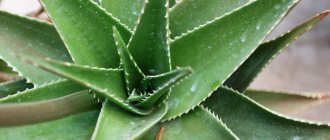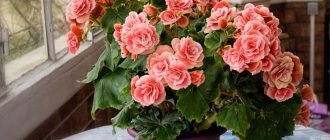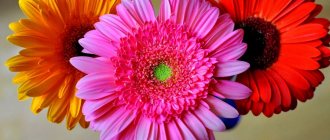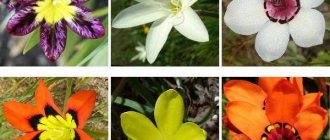The mesmerizing aroma of the flowers of the Brunfelsia plant will captivate anyone. A tropical flower will fill even the darkest room of your home with aroma. The plant also has beautiful flowers and is worthy of the attention of gardening lovers. Its peculiarity is also that the flower can successfully exist in semi-darkness. Perhaps this is your option. Read all about him in the article.
Author of the article
Maxim Sverchkov
Professional biologist and breeder with extensive experience and experience.
You can see a photo of Brunfelsia below.
Description
A herbaceous perennial with evergreen foliage belongs to the Solanaceae family. This is the closest relative of eggplants and tomatoes. At home, its height reaches 0.5 meters, while in nature it grows up to three meters.
The erect stem branches from the very base. The leaf blades are large, leathery, dark green, cold in color. Attached to the stem on small petioles. The bark is grayish-brown. The root system is well developed, powerful and branched. Over time, the roots begin to become woody.
The plant is characterized by colorful flowering. The flowers are very similar to gentian, collected in inflorescences of ten pieces. They look modest and elegant, wide open. They look striking in contrast with the foliage. Rare species have a stronger aroma than others. It contains sweet notes and spring freshness.
The flowering period begins in February and continues until early summer. Flowers open unevenly, so on the same shrub they can be of different colors. The lifespan of each specimen is short - only 2-3 days.
Avoid getting the juice on your skin, as all parts of the perennial are poisonous. When working with it, it is important to follow safety precautions. Particularly dangerous are the orange fruits that ripen on the bush.
Botanical description of the plant
Brunfelsia, depending on the variety, is a small bush or tree, but with an impressive crown. This plant does not require re-creation of tropical conditions and can bloom at the end of winter, and some species bloom for a whole year. As the flowers develop, their hue changes from deep purple to lilac or almost white.
The appearance characteristics of this flower are summarized in the table:
| Characteristic | Index |
| Root system | Powerful, extensive, woody |
| Stem | Straight, branching, leafy |
| Leaf Shape | Oval, oblong, up to 25 cm long |
| Leaf color | Olive green |
| Flower shape | An oblong tube with a five-leaf corolla, 6 cm in diameter |
| Flower color | From deep purple to white |
| Fruit shape | Oval |
| Fruit color | Orange |
| Fruit taste | The fruits are toxic |
Origin
Brunfelsia is called American because its homeland is South America, where the plant grows the size of a tree.
At home, you can grow the plant in a pot. Brufelsia is also called manaka.
Belongs to the nightshade family and is a poisonous plant! Previously, wild Indian tribes processed the plant and prepared a psychotropic drug from it for use in pagan rituals by shamans.
Brunfelsia received its name in honor of the botanist Otho Brunfels, a colleague of Carl Linnaeus. And although the plant grows rather slowly, it can sometimes reach 5-7 meters in height.
There are about 40 species in this genus, but the low-growing Brunfelsia pauciflora is suitable for growing at home. Its flowers are dark purple at the beginning and white at the end of flowering. The disadvantages include the fact that this type of plant does not smell when it blooms.
Types and varieties of Brunfelsia with photos and names
Several species and varieties of plants are grown indoors.
Brunfelsia pauciflora
Brunfelsia pauciflora 'Floribunda' photo
The most popular type. Less capricious to care for, the bush lends itself well to shaping.
Brunfelsia Photos
Beneficial features
In the process of studying the plant, scientists found many useful medicinal properties, these are:
- helps to activate the body's lymphatic system;
- has an analgesic and antibacterial effect;
- helps relieve high fever;
- has an anti-convulsant effect;
- helps cleanse the liver.
Brunfelsia grows well at home even in a dark room, it will simply bloom less and emit less fragrance. It is important not to place the plant in direct sunlight, otherwise the leaves may fall off.
Conditions for growing at home
Given suitable conditions and sufficient care, brunfelsia also feels good at home. It is enough just to muffle the direct rays of the sun and ensure the necessary humidity and temperature conditions in the room.
Did you know? Like some other plants of the nightshade family, brunfelsia, after certain heat treatment, was used by shamans as a psychotropic drug.
Place for a flower
The flower needs bright, but diffused or somewhat shaded lighting in the morning and evening hours. The east, southeast or southwest sides of the house are good for this. Direct sunlight has a negative and even detrimental effect on the plant, drying out the foliage, so direct light should be avoided by creating artificial shade.
Temperature
In summer, a comfortable temperature for brunfelsia should be +23–25 °C, although this plant is not too afraid of heat. But a drop in temperature below +9 °C at any time of the year can lead to its death. In winter, it is necessary to ensure that the temperature is maintained at +14–15 °C for two months - this will allow the plant to form buds for future flowering.
Important! Brunfelsia does not tolerate temperature changes well and may respond to cold drafts by dropping its leaves.
Air humidity
It is quite difficult for an inhabitant of the tropics to live in an apartment, especially during the heating season, so it is necessary to provide the flower with the necessary air humidity. To do this, containers with water are placed in the room, the foliage and stems of the plant are sprayed daily. For large-leaved varieties, you can gently wipe the leaves with a damp soft cloth.
Poisonous properties
Brunfelsia is extremely poisonous. Moreover, all parts are toxic.
Particularly dangerous are small fruits like miniature orange tomatoes. Keep it away from children and pets.
IMPORTANT: Do not ignore protective gloves when in contact with the plant. Its juice, if it gets on the skin, can have a bad effect on the body.
Brunfelsia is a fragrant and beautiful representative of the flora. She cannot be called unattractive, because she will captivate with her magnificence. But beauty will have to be paid for with special care.
If you are willing to tinker with the plant, it will become a decoration in your home and will live with you for a long time.
Watering and humidity
Brunfelsia requires abundant watering and constant soil moisture almost all year round.
However, during cold periods in the fall and winter, watering should be reduced, allowing the soil to dry out between waterings.
If this is not observed, excess water will cause root rot. If indoor air is dry,
be done without getting any water on the flowers. It doesn’t hurt to humidify the air with a container of water or a fountain next to the plant. Water for irrigation and spraying should be warm and settled.
Species and varietal diversity of Brunfelsias
Today, in indoor culture, one type of Brunfelsia is most widespread - the few-flowered one (Brunfelsia pauciflora). Compact, easy to mold and less capricious, it adapts better to indoor conditions and is more durable. It is her appearance that is considered typical for brunfelsias. Many attractive varieties have been bred on the basis of the few-flowered Brunfelsia:
- dark purple form of “Makranta” with flowers up to 8 cm in diameter;
- light purple form "Floribunda" with a white eye;
- purple-flowered variety 'Eximia'.
In addition to the few-flowered variety, larger species are occasionally found on sale.
The most successful option for the home is Brunfelsia pauciflora, which is most often found in indoor floriculture. It is small in size and characterized by year-round flowering of the bush. However, there are few flowers, and this distinguishes the described plant from other varieties.
Other types of brunfelsia suitable for home cultivation include the following:
- Large-flowered (or cup-shaped Francis) (Brunfelsia latifolia) is the most beautiful variety, presented in the form of a small shrub, up to 1 m in height. When young, the stem is always green and very smooth to the touch, but with age (about 3–4 years after planting) a flaky dark yellow bark forms on it. A few lanceolate leaves are arranged on the stem in an alternating order and are supported by solid short petioles. The lower part of the leaf blades is painted light green, but the upper part always has a more saturated dark green color. Sky-blue flowers are single (each 4–5 cm in diameter) or united in small loose clusters. Faded specimens turn blue-violet. Flowering begins in May and continues until the end of summer.
- Broadleaf (Brunfelsia latifolia) - characterized by wide lanceolate dark green leaves and blue flowers, which change color to white already on the 4th day after appearance. They are formed by oval, wide-open petals, which add elegance to the plant.
- Australian is an excellent option for planting in home greenhouses or gardens with sufficient free space. With a relatively small size, this variety of brunfelsia produces large flowers, up to 6 cm in diameter. All of them consist of five purple petals, which perfectly complement the green, pointed leaves.
- American (or “night beauty”) (Brunfelsia amiricana). This variety differs from the previous ones in the night-time formation of a persistent floral aroma. At first, the flowers are painted white, a little later they become creamy, and just before they dry out they acquire a yellowish color. The leaf blades of the Americana species are rich green in color, narrowed towards the petiole, widened in the middle part and pointed at the very end.
- Single-flowered - one of the largest representatives of the genus in question, characterized by thickened dark green leaves reaching a length of 10 cm. Single flowers grow up to 2.5–3 cm in diameter and during the entire time they are on the bush they change their color from purple or light blue until almost white.
- Few-flowered Francis (Brunfelsia pauciflora) is most often chosen for growing at home. The medium-sized shrub has bright green oval leaves. The plant blooms in early spring, but under favorable conditions you can observe the appearance of corollas all year round. A distinctive feature of the species is the voluminous umbrella inflorescences, due to which the leaves are often not visible.
- The southern plant variety (Brunfelsia australis) is one of the rarest. The bush is very compact (50-60 cm in length and width), while the flowers are large in size. Young inflorescences, painted dark purple, fade in a few days and become almost white.
- Brunfelsia lactea. The plant has a shrubby or tree-like growth form. Its height varies between 1.2–7 meters, the trunk measures 10 cm in diameter, covered with light brown bark. The leaf blades are oval or obovate in shape, the surface is leathery, and painted dark green. Leaf length is 5–15 cm, width is up to 2.5–6.5 cm. The flowers are arranged singly, painted in snow-white or light yellow tones, fragrant. The corolla is 5–7 cm long, 6 cm in diameter, and has 5 rounded petals. The ripening fruit is purple or light brown in color, in the shape of a fleshy berry, reaching a diameter of 2.5 cm.
- The species (Brunfelsia undulata) is characterized by very dark, narrow leaves with a glossy surface and snow-white flowers with carved edges.
Care
Location and lighting
The plant loves diffused sunlight, so the ideal place for it is a shady window sill. Direct rays will cause burns on the leaves, and in cloudy weather brunfelsia will not bloom magnificently. Place the bush on an east or southeast windowsill. On warm summer days, the indoor plant can be moved to an open balcony or garden.
In autumn and on gloomy days, move the flower to a place that is more illuminated, or use artificial lighting from time to time.
Temperature
You will have to create a climate for brunfelsia that is as close to tropical as possible. Suitable temperature range is from +12 to + 15 degrees , during the period of intensive growth the indicators increase to +20-22 degrees. In autumn, for proper formation of buds, you will have to reduce the temperature to +9-14 degrees. The wintering period lasts 8-12 weeks.
You need to switch to other temperature indicators gradually: the flower does not tolerate sudden changes in temperature, as well as drafts. Do not place brunfelsia near radiators and heating appliances.
Watering and humidity
This culture is extremely moisture-loving, so do not spare water for your green beauty.
On warm days, brunfelsia should be watered at least twice a week, on cold days - once. Do not allow water to stagnate in the pan : 10-15 minutes after watering, drain the excess. Otherwise, the roots will rot and you will not be able to save the plant. But do not allow the soil to dry out, otherwise the brunfelsia will instantly drop its buds and leaves.
Check the soil like this: dip your finger into the soil. If the top layer of soil has dried out by 2-3 cm, you can use a watering can. It would be a good idea to place the pot with the plant on a tray with pebbles (sphagnum moss) and spray it daily with a spray bottle.
Water for irrigation should be soft and clean. Do not take liquid from the tap: tap water is too hard, in addition, it is oversaturated with salts and bleach. Be sure to acidify the liquid with citric acid.
Don't forget about spraying too! Do this every day until flowering period.
Top dressing
Feed the plant moderately (it cannot tolerate excess nutrients and begins to act up) and regularly (all year round, including the flowering period). However, in November, December, January and February, fertilizers should be applied less frequently, in small doses: three or half times the dose of conventional mixtures or ammonium nitrate at a dosage of 1.5 g per liter of warm water every 3-4 weeks. The rest of the time - every 2 weeks.
Suitable mixtures: complex fertilizers for flowering crops. Use universal mixtures as a last resort: they are rather weak in composition and do not contain the required amount of nitrogen. And without nitrogen, brunfelsia will develop chlorosis very quickly.
Trimming
If you like a long plant, do not touch it and it will stretch without your help. If you want your window sill to be decorated with a compact and neat bush , do not forget about pruning.
It should be carried out in February, using sharp and disinfected garden shears. After pruning, your indoor plant will produce a lot of new shoots and look very pretty.
Transfer
Brunfelsia can only be replanted after flowering. Only young plants need annual replanting; adults can be left undisturbed for 3-4 years, however, renewing the top layer of soil annually. When buying soil, choose loose and nutritious soil that has good air and water permeability (this can also be sandy soil intended for flowering plants). You can also make it with your own hands: mix river sand, garden and leaf soil in proportions 1:2:2. Add a handful of bone meal. Pieces of expanded clay and clay shards are suitable for drainage.
The brunfelsia pot is suitable for medium size , made of clay, with sufficient drainage holes.
Remember to treat the soil before use. A conventional oven will help you with this: spread the soil mixture in a thin layer on a baking sheet and bake at a temperature of +70-90 degrees for 30-40 minutes. However, you can also use a microwave: place the soil in a thick plastic bag with holes and put it in the oven for 5 minutes. Temperature – maximum.
Why is Brunfelsia called the Yesterday-Today-Tomorrow flower or the Morning-Day-Night flower?
The flowers are initially purple or blue, turning white after a few days. They have a pleasant delicate aroma. Flowers do not bloom at the same time, so on one plant you can see flowers of different shades - from deep purple to white. For this feature, brunfelsia is called “yesterday-today-tomorrow” or “morning-day-night”.
In indoor culture, the most common is Brunfelsia pauciflora, a slow-growing shrub up to 1–1.5 m high (in nature up to 3 m). The leaves are 8-10 cm long, entire, dark green, matte, leathery. Flowers are up to 5 cm in diameter, collected in 2-10 pieces in few-flowered inflorescences.
Propagation of Brunfelsia by cuttings
How to take brunfelsia cuttings photo
Most often, brunfelsia is propagated by cuttings. You can use the material obtained after pruning: apical cuttings 8-10 cm long.
- Treat the cuttings with a growth stimulator, root in sand or perlite, or in water.
- In case of rooting in the substrate, to create a greenhouse effect, cover with a jar, a cut plastic bottle, and a transparent bag.
- Maintain the air temperature around 24 °C.
- Ventilate and moisten the soil.
- Be patient: the rooting process may take several months.
Rooted Brunfelsia cuttings photo
- When roots and young shoots appear, the young plant is transplanted into a separate container with suitable soil.
Reproduction
Brunfelsia is propagated by apical cuttings and sowing seeds. However, there is some difficulty. You will need to purchase a heated propagator for seedlings. In both cases, in addition to humidity, it is necessary to ensure that the substrate temperature is similar to the tropical one. The temperature of the substrate, despite the humidity, should not fall below 25 °C. This is an absolute requirement. Otherwise, there is no point in undertaking reproduction.
Brunfelsia flower Care at home Reproduction by cuttings Transplantation and pruning
Brunfelsia is a shrub or tree belonging to the Solanaceae family.
In the natural environment it reaches a height of 3 m, but when grown indoors it is limited to a height of about 0.5 m. The bush is spreading and lush. A pretty plant, Brunfelsia is called a tropical replacement for violets. The main advantage of brunfelsia is its colorful flowering. The flowers are similar to gentian. The tubular flowers are wide open, reach a diameter of 5 cm. They are collected in inflorescences of about 10 pieces. The color is cool white-blue, lilac, blue, yellow tones. Gardeners call the plant “yesterday-today-tomorrow” or “morning-day-night” because the initially colored corolla turns white.
Bloom
Brunfelsia americana in a pot
Flowers open unevenly, in waves, so flowers of different colors are simultaneously present on one plant. In most species, the flowers are odorless, and in some they exude a sweetish, delicate spring-like aroma. Flowering begins in February and lasts until the end of spring. The inflorescences, touching in their simplicity, instill a romantic mood.
The leaves are also decorative. They are oval-elongated in shape with pointed tips, leathery, and the color varies from bright to dark green. The leaf plates are attached alternately on short petioles, creating a lush crown.
Dangerous Beauty
Brunfelsia is poisonous - avoid getting the plant juice on your skin. To admire the graceful plant, you should make an effort, since the sweet beauty is capricious in its care.
Brunfelsia in the garden
Brunfelsia is widely grown in countries with warm climates as an ornamental shrub and hedge, but unfortunately, it does not winter in the middle zone, withstanding only a short-term drop in temperature to -1°C. Therefore, we can only enjoy the crazy flowering of bushes in apartment conditions. However, many flower growers have thought of planting plants in spacious tubs and taking them out to verandas or gazebos in the summer, decorating recreation areas in the country or in the garden.
Diseases and pests
Chlorosis is a disease that occurs when there is a lack of nutrients in the soil (iron, nitrogen, zinc, magnesium). The leaf blades turn yellow and their tips dry out. It is necessary to feed with iron chelate.
The leaves turn black along the veins - a fungal infection, the damaged parts of the plant are cut off, the flower is treated with copper-containing preparations, the soil is disinfected with copper sulfate (you can also spray the leaves and stems with it). The treatment is repeated 3-4 times with an interval of 10 days.
The color of the leaf blades is pale - the lighting is too bright.
The leaves turn yellow - due to waterlogging of the soil, the root system rots, which is why the leaves begin to turn yellow and fall off. Transplant brunfelsia urgently. Remove the affected areas of the roots, treat the cut areas with a fungicide, replace the substrate with a new one, and after replanting, water the flower with a phytosporin solution.
Insects
Among the pests that can be bothered are scale insects, aphids, and spider mites. Apply insecticide treatment.
- Scale insects are the main pest of the beautiful brunfelsia, which sucks the juices from the plant cells, causing the leaves and flowers to wither, turn pale and crumble. The only way to get rid of it is to treat the plant with insecticides.
- Spider mites are another pest that likes to attack flower crops. Its appearance can be determined by limp leaves and a thin web on the inside of the leaf. You can get rid of it using a soap solution, which you need to wash the leaves with, and then water the plant with a warm shower. If mites infested during the flowering period, spraying should not be carried out. Brunfelsia severely affected by this insect needs to be treated with an insecticide.
- Sometimes you can find aphids, whiteflies, and mealybugs on the plant. Slugs and snails can only be found when grown in a garden plot. In the event of the appearance of all these pests, it is necessary to treat the plants using special products sold in nurseries or specialized stores.
How to replant brunfelsia
Replant after flowering has finished. Young plants are replanted annually. Adult specimens need replanting once every 2-3 years, but update the top layer of soil annually. Increase the volume of the container by several centimeters. Place a drainage layer at the bottom.
The soil needs to be light, loose, nutritious, slightly acidic or acidic. Mix leaf, turf, coniferous soil, sand in equal proportions, add a little bone meal. You can mix garden soil, leaf soil, coarse sand in a ratio of 2:2:1, add peat.
Interesting facts about Brunfelsia
Some varieties of Brunfelsia, in particular large-flowered and single-flowered (Brunfelsia grandiflora, Brunfelsia uniflora) in the territories of its natural growth are usually added to the traditional drink Huasca, which causes hallucinations. The plant also has a neurotoxic effect, which can cause severe poisoning in livestock, since parts of brunfelsia contain a substance such as brunfelzimidine, the derivatives of which are pyrrole and gaunidine (1 - has a strong acidic effect, 2 - has fungicidal and bactericidal activity).
Since it is called “manaka” in its homeland, the plant owes this name to an old legend. This was the name given to the most beautiful girl in the Brazilian Tupi tribe, and she loved most of all these blue flowers blooming on the bushes. She was the first woman to brew a potion from tender buds that helps with unhappy love. After some heat treatment, Brunfelsia, like many plants from the nightshade family, can be used as a psychotropic drug. Therefore, shamans in the tribes of South America or the West Indies revered the plant as sacred and used it in magical rituals.
Attention!!! Brunfelsia is considered a highly poisonous plant, so when caring for it you will need to take certain safety measures, especially when it comes to being in rooms where there are small children or pets. This is due to the fact that the fruits ripening on the bush, which in their outlines resemble small “tomatoes”, colored orange, containing multiple seeds. It is these parts of the plant that pose particular danger.
In Brazil, Brunfelsia has a very incomprehensible name: “yesterday-today-tomorrow” or “morning-noon-night”. Naturally, this is incomprehensible to a person who has never encountered a flower. But everything is explained by the rich color palette of various shades of lilac and violet colors that decorate the petals of multiple buds; there are so many of them that sometimes the foliage is completely hidden behind the abundance of flowers.
They say that the phrase that has become a kind of motto of the plant is: “Don’t think about yesterday - it will make you cry. Don't think about tomorrow - it will make you worry. Live and think about today - it will make you laugh! ”, came up with one gardener who took just one look at the multiple Brunfelsia flowers covered in different color shades.
Plant diseases
Sometimes brunfelsia pleases with its painful appearance.
- Brunfelsia often suffers from leaf chlorosis , which indicates too hard water.
- Buds fall off - dry air or insufficient watering.
- The plant does not bloom - there is no dormant period.
- Leaves fall off - drying out or waterlogging of the soil.
- The leaves turn yellow - direct rays of the sun on a south window or a lack of microelements.
Video
Sources
- https://flowers-home.info/brunfelsiya-uhod-vyrashhivanie-v-domashnih-usloviyah-razmnozheniya/
- https://tsvetem.ru/tsveti_v_dome/brunfelsiya-uxod-v-domashnix-usloviyax.html
- https://kachestvolife.club/rasteniya/brunfel-siya-vidy-i-sorta-posadka-i-uhod-v-domashnih-usloviyah
- https://komnatnyecvety.ru/brunfelsiya/
- https://selo.guru/rastenievodstvo/derorativ/brunfelsiya.html
- https://www.botanichka.ru/article/ekzoticheskaya-brunfelsiya/
- https://CampusMpei.ru/sad/brunfelsiya-uhod-v-domashnih-usloviyah-2.html
- https://sad1rzd.ru/sad/brunfelsiya-monako.html
- https://kubus-expo.ru/sadovodstvo/komnatnyj-tsvetok-brunfelsiya-soderzhanie-i-uhod-v-dome.html
- https://chto-posadit.ru/tsvetok-brunfelsiya-uhod-v-domashnih-usloviyah-razmnozhenie-cherenkami-peresadka-i-obrezka/
- https://www.supersadovnik.ru/text/brunfelsija-1009255
- https://floral-house.ru/tsvetushchie/brunfelsiya-malotsvetkovaya.html
- https://tutknow.ru/garden_and_orchard/7024-brunfelsiya-pravila-vyraschivaniya-v-domashnih-usloviyah.html
Caring for brunfelsia at home
The flower is sensitive to changes in the external environment, prefers bright lighting without direct sunlight. For long-term flowering, from March to September they maintain -16...-18 °C, in winter they lower it to -9...-14 °C, thereby stimulating the formation of buds.
Brunfelsia requires high humidity and regular watering without stagnation of water. In spring and summer, water up to three times a week, using water at room temperature; during cool wintering, the frequency is reduced.
In autumn and winter, fertilize once a month with reduced doses of complex mineral fertilizers; during the growing season, fertilizing is applied 2 times a month.
Replanting, pruning
During the growth period, an annual transplant into a larger container with a change of soil and drainage is necessary. Mature plants are replanted every 4 years, replacing the top 3 cm of soil.
Ready-made soil for roses is suitable for growing; it is also possible to use a mixture of leaf soil, turf, peat and sand, taken in a ratio of 2:2:1:1. They stimulate the growth of young branches and the formation of flower buds by pruning the bush after flowering, removing up to 50% of the branches.
Reproduction
Propagated by cuttings or stem shoots. At the beginning of spring, 10 cm of the top of the shoot with 3 buds is cut off and soaked in compounds that stimulate the formation of roots.
The cuttings are planted in a common container and covered with film or a glass jar. Roots form after a few months, after which the plants are transplanted into pots.
At home, the features of caring for cuttings are to ensure a constant temperature of +25 °C and regular ventilation.
Diseases, pests
The plant is resistant to diseases and pests, and can be affected by aphids and spider mites. Infection can be identified by the following signs:
- the appearance of yellow, deformed leaves;
- sticky coating, cotton-like lumps on the leaves;
- black or green bugs on stems.
To control pests, use a soap or alcohol solution, applying the composition to a cotton pad; the pests are collected manually, after which they are treated with insecticides.
The most common diseases are chlorosis, as a result of improper soil selection, and various rots that form due to excessive watering.











